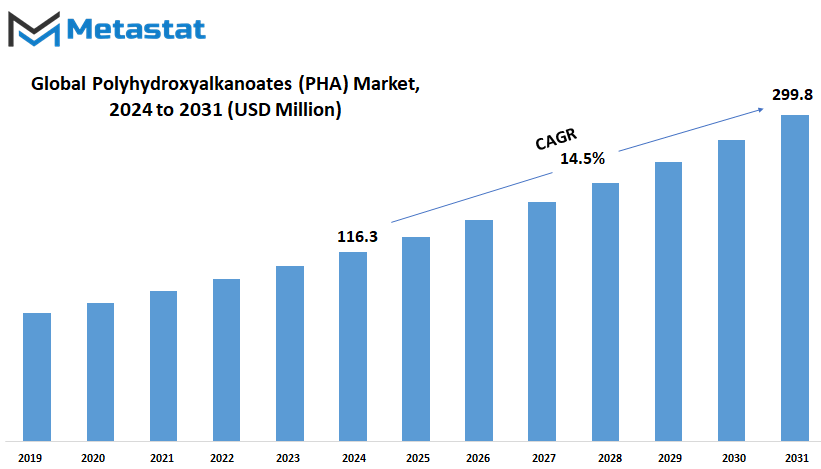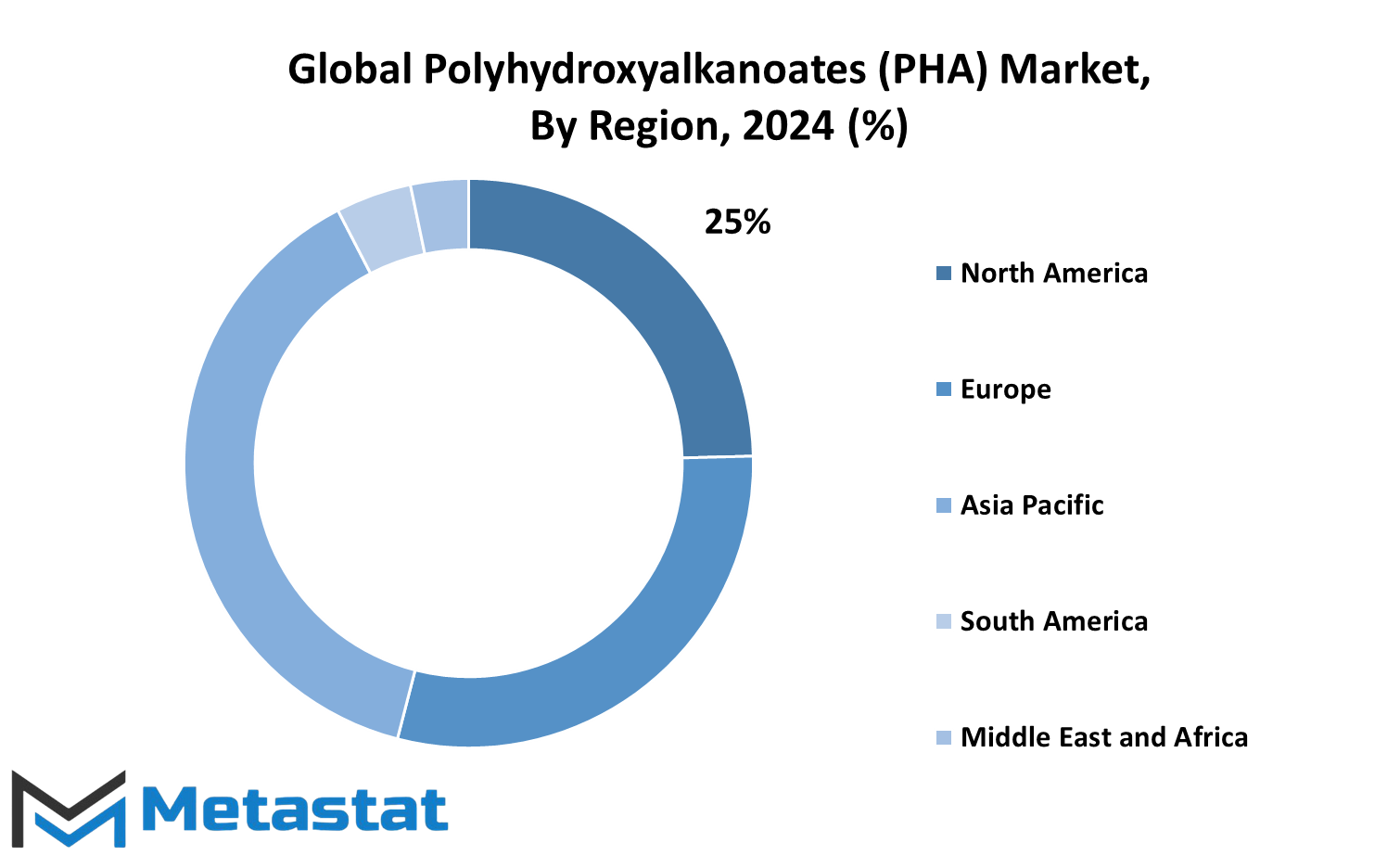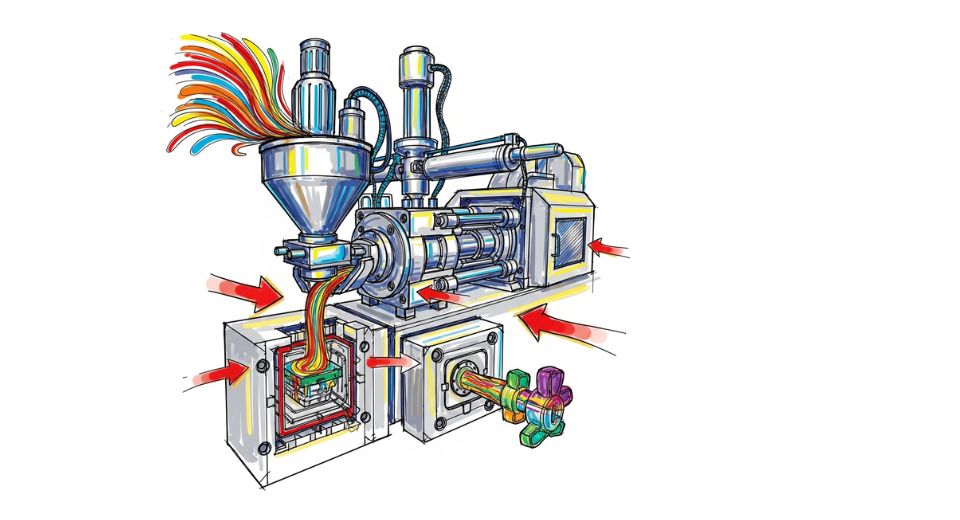MARKET OVERVIEW
The global PHA market is a key element in the bioplastics industry with respect to the production and distribution of biodegradable polymers based on microbial fermentation. Such polymers, called Polyhydroxyalkanoates (PHA), have been realized as having huge potential for substitution of traditionally used plastics produced from petrochemicals. With growing environmental concerns and regulations pushing industries toward more sustainable solutions, PHAs have come to be seen as a very promising alternative, given their biodegradability and renewable origins.
This is a market defined by the role it plays in the production of biopolymers: environmentally friendly, versatile in applications. This defines the PHA industry: renewable resources of sugar, starch, and vegetable oils form the base for their biodegradable plastics. On this factor, PHAs stand out from other bioplastics, so they become special areas of interest where impact on the environment is crucial.
The Global Polyhydroxyalkanoates Market will witness growth in demand, riding on various industries, including packaging, agriculture, and medical devices. As industries try more and more to reduce their carbon footprint and work by the regulations put down, PHAs will turn out to be one of the preferred materials for manufacturers who are seeking to offer green products. This versatility allows PHAs to cover a wide range of applications, from food packaging and disposable items to more complex uses like medical implants and agricultural films.
One of the more unique aspects of the global polyhydroxyalkanoates market is its potential for material science innovation. New routes to PHAs’ properties and their production processes are constantly being explored by scholars and producers to make them more competitive against traditional plastics. Improvements in microbial engineering, fermentation technology, and feedstock use are assumed to improve PHA performance and lower production costs, thus further raising the attractiveness of this market.
The PHAs market will, therefore, play a much larger role in this transition to a circular economy. Unlike traditional plastics, which are polluting and create landfill and ocean waste, PHAs are naturally degradable in the environment, reducing landfills and oceans. This property of biodegradability is a key reason driving interest in the Global Polyhydroxyalkanoates Market, particularly in regions where infrastructure for waste management is poor or lacking.
Growing awareness about the environment and the effects associated with plastics will also derive benefits for the global Polyhydroxyalkanoates market. With the rising sensitization of customers and businesses to their ecological footprint, demand is expected to rise for biodegradable and renewable materials, further driving investments in PHA production facilities and pushing more companies to adopt PHAs in their product lines.
In the final analysis, the global PHA market will be one of the powerhouses of the sustainable materials industry. The potential capacity to provide environmentally friendly alternatives to traditional plastics and the continued development of innovative production technology have made this one of the most critical fractions of the future of bioplastics. PHAs are thus expected to play a progressively pivotal role across different industries as this market continues to develop in order to ensure that many industries and products move in the right direction towards sustainability.
Global Polyhydroxyalkanoates (PHA) market is estimated to reach $299.8 Million by 2031; growing at a CAGR of 14.5% from 2024 to 2031.

GROWTH FACTORS
The global PHA market is projected to witness exponential growth over the next few years, driven by a number of key factors. Of these, one major driving factor is the growing demand for biodegradable plastics. Industries and consumers alike are now shifting with concern towards the environment to more sustainable alternatives. Since PHA is a biodegradable polymer, it offers a very promising solution in reducing plastic waste and hence turns out to be an attractive material for different applications. Government policies and regulations also support market growth by reducing carbon footprints and promoting eco-friendly materials. Most of the time, these policies include incentives for companies that adopt green technologies, hence encouraging more investment in PHA production.
Another driver for the market is the increasing awareness among consumers about the hazardous effects of conventional plastics on the environment. The awareness of the same is increasing the trend toward products made from sustainable materials. As more consumers begin to demand green products, the demand for PHA-based products will accordingly increase and thus market growth. Moreover, biotechnological innovations have been making the production of PHA more affordable and efficient, ultimately lowering the overall cost of production. Such cost-reduction is most likely to make PHA products more approachable and attractive to a much larger range of industries, such as packaging, agriculture, and medical sectors.
However, growth in this market is not free of challenges. One major challenge is the high production cost of PHA when compared with conventional plastics. Even with the advancement of technologies, the raw material cost and the complexity in the production process keep it relatively on the higher side. This cost factor may impede the general acceptance of PHA, especially in the price-sensitive markets. Moreover, availability of other biodegradable materials may also impact the market. These materials produced usually at a lower cost may give limited share to PHA in some of the applications.
Despite all this, the future for the global PHA market seems to be promising with various opportunities lined up. New uses of PHA in biomedicine and agriculture could open up new revenue flows. Besides, development of the continuous production process and reduction of costs will establish the market in a much more competitive position. With industries seeking sustainability solutions, rapidly growth is expected in the global PHA market through innovation and increasing demand for eco-friendly products.
MARKET SEGMENTATION
By Type
The global Polyhydroxyalkanoates market is likely to benefit from significant growth in the forecast period owing to the increasing demand for sustainable and biodegradable materials. One such biopolymer, polyhydroxyalkanoates (PHA), tends to offer a quite eco-friendly substitute to traditional plastics. They are biodegradable in nature because they are produced through microbial fermentation of sugars or lipids. With the greening of the world, PHA is foreseen to find more and more uses in multiple industries related to packaging, agriculture, and medical applications.
One of the major drivers of the global PHA market growth is the rising awareness about the environment and the issues related to it. Consumers and companies alike are striving to find products with reduced environmental impact. This shift in consumer behavior is compelling the manufacturers to concentrate on bioplastics like PHA that can degrade naturally and, eventually, reduce plastic pollution. Besides, governments of countries across the world are also framing regulations against single-use plastics, thereby accelerating the demand for biodegradable materials.
Market segmentation of the Global PHA market based on type includes Short Chain Length and Medium Chain Length PHAs. Most of the PHAs with short chain lengths normally find application in packaging materials and agricultural films due to their properties, which include excellent biodegradability and mechanical properties. Such PHAs are able to replace conventional plastics in many applications since they offer almost the same level of performance with added advantages to the environment. In turn, the Medium Chain Length PHAs are noted as being flexible and elastic; hence, they find their way into medical applications such as sutures and drug delivery systems. Increasingly biocompatible and biodegradable materials, such as medium-chain length PHAs, will be in demand with advancing medical technology.
The future of the global PHA market is most likely to be endowed with innovative techniques for production that can reduce the cost of these biopolymers, hence supplying them to more industries. Although biotechnological developments may enable new PHA types with better properties, thereby broadening the horizon of applications, a growing focus on sustainability will bring PHA more to the forefront in plastic waste reduction and fostering environmental responsibility. The global PHA market will be a leading player in the turn to a more sustainable future with solutions that replace traditional plastics, and a cleaner and healthier planet.
By Production Method
Introduction The one big driving factor for the PHA market is the ever-increasing movement toward sustainable alternatives by shifting industries from traditional plastics. PHA is a class of biodegradable polymers produced by various fermentation processes, so these are considered environmentally friendly choices in many uses. The market has been segmented according to the production methods such as sugar fermentation, vegetable oil fermentation, and methane fermentation. All these techniques have varied advantages and are thus projected to shape the future of the PHA market.
One of the most common ways to produce PHAs is through sugar fermentation. The crops that give the necessary sugar for this process are crops like corn, sugarcane, or beets. Fermentation changes these sugars into PHA to be later transformed into a number of biodegradable products. With the support of an increase in the demand for sustainable materials, sugar fermentation is likely to be the most popular method due to raw material availability and process efficiency. However, concerns about the use of food crops for industrial reasons need to be considered and may lead to further research on the availability of sugar from different sources or more efficient production techniques.
Another method gradually gaining popularity in the PHA market is the use of vegetable oil. This process can utilize vegetable oils, such as soy or palm, or canola, for PHA production. Vegetable oils are a feedstock of great versatility, and various kinds of PHA could be produced using this method with specific characteristics according to the oil used. With increasing global awareness of environmental issues, exploitation of vegetable oils, especially non-food crops, may gain further momentum. This technique also leaves the option to use waste oils that further reduce production costs and improve green credentials of PHAs.
The other method that has been less explored relatively but remains very promising is fermentation of methane to produce PHAs. A potent greenhouse gas, methan, is used as feedstock in this process. Its conversion into PHA makes a good product, reducing atmospheric hazards of greenhouse gases. The technique is in line with the global trend of using low-carbon technology to reduce carbon emissions and counteract climate change, thus the prospect for enormous future development of the PHA industry. With better technology, the cost of methane fermentation may become effective in the future, generating interest in large-scale production.
With the entire world slowly reaching out to sustainable materials, the global PHA market also has bright prospects. Besides, most routes to production are still under development, with sugar, vegetable oil, and methane fermentation leading the way. This market should grow as these methods are refined, promoting a more sustainable future.
By Application
Global Polyhydroxyalkanoates (PHA) Market is poised to grow in the upcoming years due to its escalating applications in end-user industries. PHAs are biodegradable polymers that can be produced by microorganisms and can potentially be very good replacements for synthetic polymers in many end-user industries. With the world on the lookout for better alternatives and with the very evident environmental and health impacts that conventional plastics are causing, the need for these alternatives is going up day by day.
Among the most apparent applications, PHAs are largely applied in the packaging and food services industry. With recent and growing consumer pressures concerning such factors as good environmental practice and the sourcing of food products, there is an increasing demand for biodegradable consumer packaging. Several limitations and strict regulations regarding plastic waste put a lot of pressure on the food chain companies to use packaging materials based on PHAs. It is evident that this is an upward trend in the future upon the realization of PHA and the development of sustainable packaging solutions. With the technology at a more mature level and the cost of production low, other companies are also likely to adopt this for their packaging solutions.
Another major field where PHA is applied is the biomedical field. Being biocompatible, PHAs are used widely in the medical sector for tissue engineering, wound healing, and drug delivery. As already mentioned, biodegradable and biocompatible materials are currently being accepted in this area worldwide and demand is increasing; likewise, it is the same for the utilization of PHAs. In the next years, applications of PHA in the biomedical field should increase based on research and development.
PHA exhibits wide application potential, one of them being in the agriculture sector. PHAs are used to form biodegradable agricultural films, which cannot be formed using other materials. These results establish the great potential application of PHAs in the huge agricultural industry. Agricultural films improve the environmental effects of traditional plastic films. Agricultural mulching using agricultural films improves soil moisture preservation, suppresses weed growth, and enhances crop yield. The demand for PHA-based products will be enhanced at the global level as the agricultural industry will take more PHA-based products as it proves to be unsustainable.
Other markets that are seeing a surge at an increasing rate are the PHA markets for the future, considering an increasing level of awareness and falling production costs. Considering its multipurpose, application-indifferent nature, which can be a substitute for regular plastics in all areas, PHA is the key player material of the sustainable future. Since industries are moving toward environmental awareness, more experienced use likely means higher demand, making it a part of transitions toward a more sustainable future.
|
Report Coverage |
Details |
|
Forecast Period |
2024-2031 |
|
Market Size in 2024 |
$116.3 million |
|
Market Size by 2031 |
$299.8 Million |
|
Growth Rate from 2024 to 2031 |
14.5% |
|
Base Year |
2022 |
|
Regions Covered |
North America, Europe, Asia-Pacific Green, South America, Middle East & Africa |
REGIONAL ANALYSIS
The global market for PHA holds huge potential across different regions. Though demand for sustainable and biodegradable materials is rising, geographical regions are really diverse regarding both opportunities and challenges that the growth and development of the PHA market may face. This regional analysis gives insights into the current trends and future possibilities for PHA adoption worldwide.
In North America, growth is quite stable due to stringent environmental regulations and growing consumer preference towards green products. The United States forms the main driving force in terms of demand for PHAs with increased investments in research and development of bioplastics. Canada and Mexico are also growing the market, although on a smaller scale, mainly through government initiatives and industrial applications.
Europe remains in the lead of the global PHA market, driven by strict environmental policies and a very proactive approach to solving the problems related to plastic waste. These include the United Kingdom, Germany, France, and Italy—countries that have put in place governments that drive companies toward PHA use in packaging, agriculture, and other sectors. The remaining European countries follow closely, driven by raising awareness and building an infrastructure that supports bioplastic production and use.
The market for PHA is held significantly by the Asia Pacific region, majorly by countries such as China, India, Japan, and South Korea. Rising urbanization and industrialization in these nations, coupled with increasing concerns about the environment, boost the demand for alternatives like PHAs. With its large production capacity, China will likely take center stage in the global supply chain of PHAs. Japan and South Korea would master technological developments necessary to raise production efficiency. India is slowly catching up, with rising investments in sustainable materials to meet growing environmental challenges at home.
South America is the rising continent for PHA, with Brazil and Argentina—boasting of strong agricultural sectors that supply the main raw materials needed for PHA production—leading the way. Although there is a nascent market for PHA, huge growth potential is foreseen with rising awareness toward environmental sustainability across the region.
The Middle East & Africa region, including countries such as the GCC nations, Egypt, and South Africa, is just starting to realize the importance of biodegradable materials. Presently small, the market will grow as more and more governments and industries in these regions invest in sustainable practices and infrastructures in the future.
Hence, the global polyhydroxyalkanoates market is expected to grow drastically in all regions. As the world becomes increasingly environmentally conscious, with a move toward greener living, PHAs are expected to make a strong mark and, therefore, further opportunities in innovation and market growth in the near future.

COMPETITIVE PLAYERS
The global Polyhydroxyalkanoates (PHA) market is expected to experience significant growth in the coming years, driven by the increasing demand for sustainable and eco-friendly materials. As awareness of environmental issues continues to grow, there is a rising interest in biodegradable plastics, and PHA is emerging as a promising solution. This trend is attracting several companies to invest in the development and production of PHA, positioning themselves to meet the future demand for green alternatives to conventional plastics.
Among the key players in the global PHA market are Danimer Scientific, RWDC Industries, Bio-on SpA, Bluepha Co., Ltd., Mango Materials, PolyFerm Canada Inc., Shenzhen Ecomann Biotechnology Co., Ltd., Kaneka Corporation, and CJ CheilJedang Corporation. These companies are at the forefront of innovation in the PHA industry, each bringing unique approaches to the production and commercialization of PHA.
Danimer Scientific, for instance, is recognized for its commitment to producing biodegradable materials that can replace petroleum-based plastics. The company’s efforts in developing PHA have positioned it as a leader in the market, with significant potential for future growth. Similarly, RWDC Industries is focusing on sustainable solutions, using PHA to address the global plastic waste problem. Their innovations in PHA production are contributing to the broader adoption of this material in various industries.
Bio-on SpA is another significant player, known for its advanced technology in producing high-quality PHA from renewable resources. The company’s emphasis on research and development is helping to push the boundaries of what PHA can achieve, particularly in creating new applications for the material. Bluepha Co., Ltd., and Mango Materials are also making strides in the industry, with a focus on reducing the environmental impact of plastic waste through innovative PHA production processes.
Looking forward, the competition among these players is likely to intensify as the global demand for sustainable materials increases. The future of the PHA market will be shaped by ongoing technological advancements, collaborations, and the ability of these companies to scale up production to meet the rising needs of various industries. As the market evolves, companies that can effectively address both the environmental challenges and the practical demands of consumers will be well-positioned to lead the global PHA market in the coming years.
Polyhydroxyalkanoates (PHA) Market Key Segments:
By Type
- Short Chain Length
- Medium Chain Length
By Production Method
- Sugar Fermentation
- Vegetable Oil Fermentation
- Methane Fermentation
By Application
- Packaging & Food Services
- Biomedical
- Agriculture
- Others
Key Global Polyhydroxyalkanoates (PHA) Industry Players
- Danimer Scientific
- RWDC Industries
- Bio-on SpA
- Bluepha Co., Ltd.
- Mango Materials
- PolyFerm Canada Inc.
- Shenzhen Ecomann Biotechnology Co., Ltd.
- Kaneka Corporation
- CJ CheilJedang Corporation
WHAT REPORT PROVIDES
- Full in-depth analysis of the parent Industry
- Important changes in market and its dynamics
- Segmentation details of the market
- Former, on-going, and projected market analysis in terms of volume and value
- Assessment of niche industry developments
- Market share analysis
- Key strategies of major players
- Emerging segments and regional growth potential








 US: +1 3023308252
US: +1 3023308252






